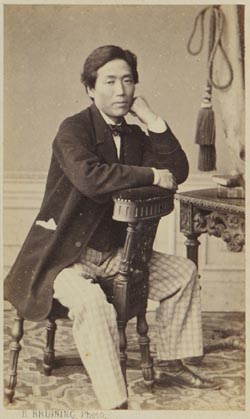Nederland - Japan > 1862: Japanse bezoekers in Nederland

Het Japanse Tokugawa-Shogunaat dat in 1600 is begonnen, heeft in het midden van de negentiende eeuw zijn langste tijd gehad. Verschillende westerse staten hebben handelsverdragen afgedwongen met het land. Japan moet wel, het kan niets beginnen tegen de moderne westerse wapens. De Shogun realiseert zich dat hij zijn macht alleen kan handhaven door te moderniseren.
In deze periode worden verschillende ambassadeurs en groepen studenten naar de westerse wereld gezonden. Een aantal komt naar Nederland. In 1862 arriveert de Takeuchi-delegatie en wordt hoffelijk ontvangen. De Japanners krijgen een audiëntie bij de Nederlandse koning Willem III en bezoeken daarna verschillende Nederlandse steden en bedrijven. Een jaar later komt een groep Japanse studenten naar Nederland, die hier verschillende jaren zullen verblijven. De meeste zijn marineofficieren die hier kennis komen opdoen over zeevaarttechnieken. Twee van de studenten, Tsuda Mamichi en Nishi Amane, krijgen van de Leidse Professor Simon Vissering privéles over recht en politiek.
Het helpt allemaal niet; de positie van de Shogun verzwakt steeds verder. In 1868 draagt hij de macht over aan de partij die de keizer steunt. Deze overdracht staat bekend als de Meiji-restauratie en is het begin van de Meiji-periode. In de nieuwe situatie verliezen de Nederlanders hun uitzonderingspositie. Ze moeten met lede ogen aanzien hoe andere Westerse landen hun invloed en aanwezigheid uitbreiden. Nederlandse bedrijven blijven echter tot en met vandaag actief in het land van de rijzende zon.
